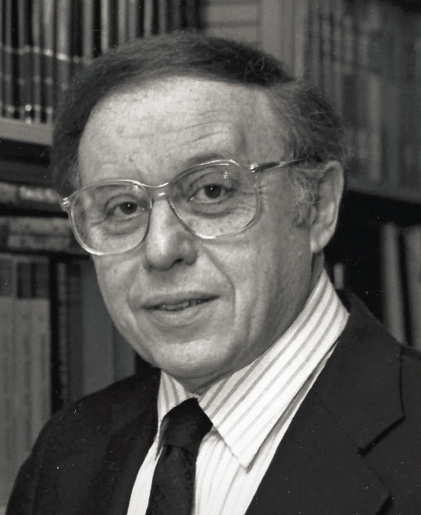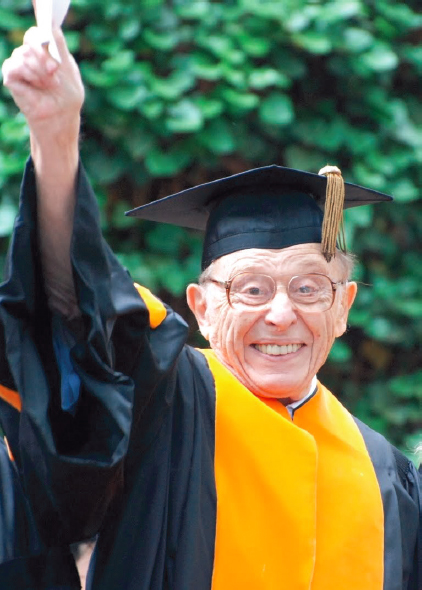

IRVIN GLASSMAN
1923–2019
Elected in 1996
“For contributions as researcher, author, editor, and educator in combustion and propulsion.”
BY CRAIG T. BOWMAN, FREDERICK L. DRYER, WILLIAM A. SIRIGNANO, AND RICHARD A. YETTER
IRVIN GLASSMAN passed away December 14, 2019, at the age of 96. We miss now an extraordinary colleague and friend, well known for highly energetic, productive, and impactful engagement in research, teaching, mentoring of younger colleagues, editorial leadership, and organizational development. Through these activities, he was a very prominent leader both in defining the modern field of combustion science and engineering and in mentoring undergraduate and graduate students.
Born September 19, 1923, in Baltimore, Maryland, Irv Glassman was educated in the public schools and graduated from Baltimore City College in 1940. His life was a testament to the transformative power of education. A scholarship to Johns Hopkins University (JHU) enabled him to leave his mother’s grocery store, obtain undergraduate and graduate degrees in engineering, and eventually become a professor at Princeton University. He earned a bachelor of chemical engineering degree at JHU in 1943 and immediately joined the US Army, working on the Manhattan project at Columbia University while serving for the rest of World War II. He returned to JHU and received a doctorate in chemical engineering in 1950.
___________________
The authors appreciate input from Robert Socolow, former director of Princeton’s Center for Environmental Studies (1979–97).
He then joined the newly created Daniel and Florence Guggenheim Jet Propulsion Center in the Aeronautical Engineering Department at Princeton as a research associate, assigned to work on designing supersonic nozzles. He advanced to the research staff in 1954, leading the experimental ramjet research effort. He was appointed assistant professor of aeronautical engineering in 1955, and promoted to associate professor in 1959 and professor in 1964 in the newly formed Department of Aerospace and Mechanical Sciences (now the Department of Mechanical and Aerospace Engineering).
Irv’s early research led to his recognition of the importance of fuel properties to rocket performance and instability. It also stimulated his overarching career interests in chemical effects on fire safety, propulsion, energy conversion, and environmental emissions.
His research was done mostly at the Guggenheim Laboratories on Princeton’s Forrestal Campus until 1973, when the research moved to the main campus to involve more undergraduates and to advance the newly established Center for Energy and Environmental Studies, which Irv directed until 1979. He was also appointed the American Cyanamid Professor of Environmental Sciences (1972–75), the Robert H. Goddard Professor of Mechanical and Aerospace Engineering (1988–99), and MAE department chair (1989–90).
Irv was instrumental in founding the Center for Environmental Studies in Princeton’s School of Engineering and Applied Science (1971), was its director (1973–78), and remained involved as mentor and behind-the-scenes supporter. (In 1974 the center’s name was changed to the Center for Energy and Environmental Studies in recognition of the centrality of energy issues to an environmental center in an engineering school.) As director, Irv ensured the center’s future and its autonomy as he appointed its first senior research staff and helped secure its early funding. Under his leadership the center launched programs in nuclear power, renewable energy, energy efficiency, sustainable development, and land use. The center became broadly recognized for innovative thinking, interdisciplinarity, international collaborations, and
the mentoring of graduate students and intrepid early-career scholars reorienting their careers.
Over his half-century career at Princeton and as professor emeritus since 1999, Irv contributed broadly and extensively to applications-inspired fundamental combustion science and technology. His earliest work addressed propellants for air and space propulsion applications, including impacts on combustion instabilities. The effort gave emphasis to gas-phase behavior; chemical kinetic properties of hydrogen/oxygen, methane, and storable spacecraft propellants; and metals combustion. He postulated the “Glassman criterion” for characterizing when and how metal oxide condensation affects a metal’s burn rate.
He subsequently turned to fuels-related work in ground and air transportation, including carbon monoxide oxidation and hydrocarbon pyrolysis/oxidation, especially of alkylated and aromatic fuel components. Through these fuel studies, he contributed substantially to fire safety, elucidating the phenomena controlling flame spread over solids and over fuel spills and through stratified fuel vapor/air mixtures and pool fires. His work on sooting in premixed and diffusion flames, especially for aromatics, significantly enhanced characterization of fuel properties related to radiative transfer in gas turbine combustors and emissions of nitrogen oxides, carbon monoxide, and soot from combustion systems.
Irv thought deeply about the chemical and physical issues related to a problem, demonstrating extraordinary knowledge and fundamental insight and, importantly, considering the implications of the applied findings. Though many of his major contributions were experimentally inspired, a hallmark of his work was developing insights that advanced theoretical understanding, especially chemical-kinetic and thermodynamic-related aspects, while also acknowledging the influences of molecular transport processes and fluid mechanics.
Leading contributors in academia and industry have emerged from his stellar mentoring of undergraduate and graduate students, postdocs, professional research staff, and
visiting scholars. His former students now form a significant leadership group in combustion science and engineering; 21 of his 35 PhD students became faculty members at major universities; three of them are now members of the National Academy of Engineering; and another was elected to the Canadian Academy of Engineering.
His strong emphasis on connecting applications to fundamental work led to his advisory roles with the National Research Council (for example, as a member of the committee that advised EPA administrator William Ruckelshaus on the schedule for the 1970 Clean Air Act) and NATO, and consultancies for prominent corporations such as United Technologies and Chrysler. He authored about 250 scholarly articles and two books. His textbook Combustion, first published in 1977 (Academic Press), is now in its fifth edition. Like his lectures, it emphasizes the understanding of simple physical concepts, instilling an ethos for lifelong learning and imagination.
Irv also enjoyed editing, beginning with his involvement as associate technical editor of the Journal of the American Rocket Society (1951–64), predecessor of the AIAA Journal. He founded the journal Combustion Science and Technology in 1971 to convey the more applied aspects of combustion science to the broader community. These legacy publications will continue to mentor new leadership in the field of combustion for many decades to come.
Professor Glassman was recognized by the Combustion Institute as an inaugural fellow “for pioneering studies on the chemical kinetics of combustion systems with a particular emphasis on aromatics and soot,” and in 1982 he received the institute’s Egerton Gold Medal “for distinguished, continuing, and encouraging contributions to the field of combustion.” In other recognition of his extraordinary contributions to education and research, he received the 1984 Ralph Coats Roe Award from the American Society for Engineering Education; was elected to the NAE in 1996; and was a fellow and 2018 Daniel Guggenheim Medalist of the American Institute of Aeronautics and Astronautics (one of the greatest honors for a lifetime of contributions to aeronautics). In 2011 the Eastern
States Section of the Combustion Institute established the Irvin Glassman Young Investigator Lecture and Award to recognize rising contributors in the field. In 2009 Irv was awarded an honorary doctor of science degree by Princeton University. The announcement stated:
His half-century of research and teaching defined a field that propelled us to the moon and started us on the path to more efficient use of energy. He insisted, for himself and his students, on a deep understanding of the science behind the chaos of a flame, sending forth scores of new leaders who now populate the field. His gift for looking ahead led him 35 years ago to see beyond the raw power of fuels and train his energy on challenges to the environment, sparking a field of critical importance today that may determine our quality of life tomorrow.
Irv is survived by his wife of 68 years, Beverly (née Wolfe); their three children, Shari Powell (Warren), Diane Gienger (Edwin), and Barbara Glassman (Arthur Rubin); and six grandchildren.
In addition to his personal family, Irv was instrumental in creating a large and devoted “Princeton family” in the combustion community, to which many graduates of the Princeton Mechanical and Aerospace Engineering Program, as well as their colleagues in academia and industry, belong. He was very proud of his legacy as a teacher.
Through his interest in others, kindness, and positive outlook, Irv became not only a teacher but a lifelong mentor to many of his academic “children.” In 1972 he instituted the tradition of a biennial Princeton reunion at the International Combustion Symposia, which continues to this day.
The strong influence of the Princeton family in the combustion community and his numerous and wide-ranging scholarly contributions define the professional legacy of Professor Irvin Glassman.






